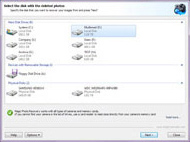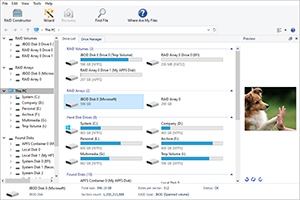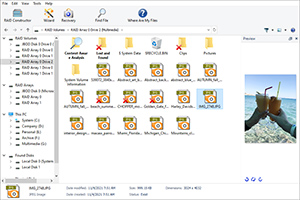RAID Recovery Tool Restores Data from Corrupted RAID Arrays

Magic RAID Recovery by East Imperial Soft is designed to help users repair many types of corrupted RAID arrays and recover information from single-disk and multiple-disk volumes created in popular DAS and NAS devices as well as a wide range of RAID controllers manufactured by HP, Dell, Adaptec, IBM, Intel, Fujitsu, Silicon Image, LSI, ASMedia, Broadcom, and many others.
Features and Benefits of Magic RAID Data Recovery Software
Rebuild Corrupted RAID Arrays
- Rebuild and repair corrupted RAID arrays created in Windows, Linux, macOS, and NAS devices;
- Mount multiple-disk volumes if the original storage device or RAID controller is broken or unavailable;
- Supports RAID 0, RAID 1, RAID 4, RAID 5, and RAID 6;
- Supports RAID 1E, RAID 5E, RAID 5EE, X-Raid, Raidz and many types of composite arrays including RAID 01, RAID 10, RAID 50, and RAID 60.
Recovering Data from NAS and DAS Devices
- Mount multi-disk volumes and RAID arrays regardless of the type of RAID controller;
- Automatic detection of disk order and array configuration parameters;
- Recover data from logical volumes spanned across multiple disks;
- Recover data from corrupted single-disk volumes and JBOD arrays;
- Extract files and folders from degraded and corrupted arrays without a lengthy rebuild/resilvering (for mirrored or checksum-based arrays).
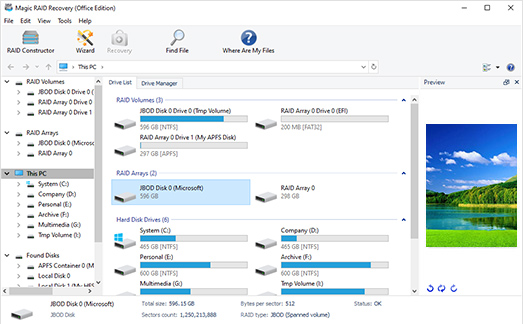
How to Use RAID Array Recovery Software
- #1 Select Open the RAID repair software and select the RAID you would like to analyze.
- #2 Build In addition to the auto-generated RAID, you can build it manually.
- #3 Analyze Choose “Fast scan” or “Full analysis” and let the program run the analysis.
- #4 Recover Select the required files or recover the entire contents of damaged RAID.
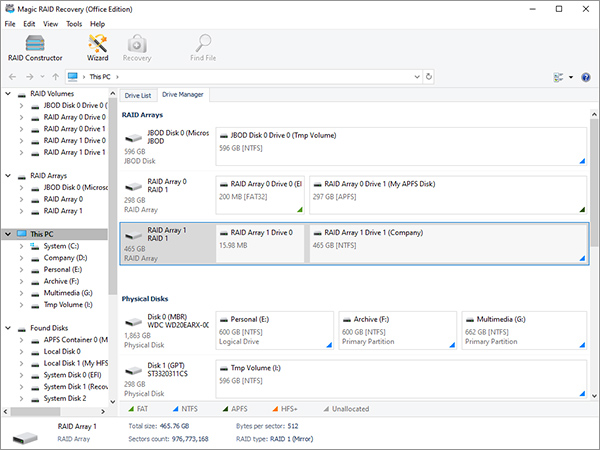
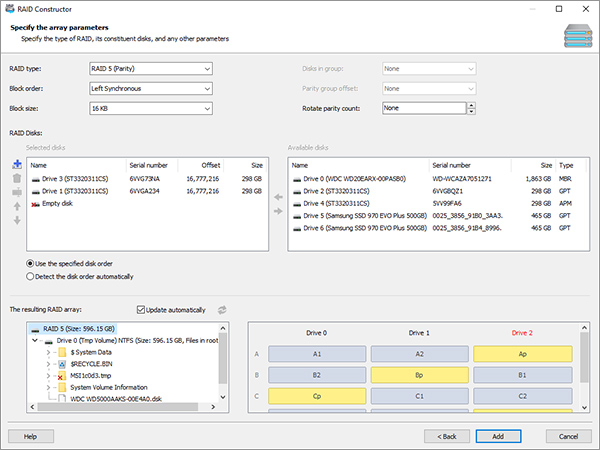
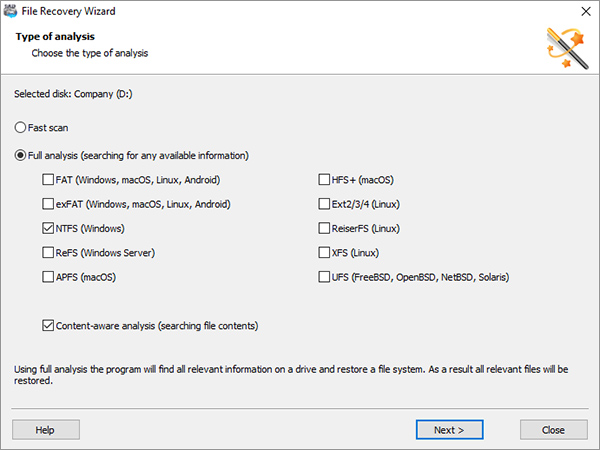
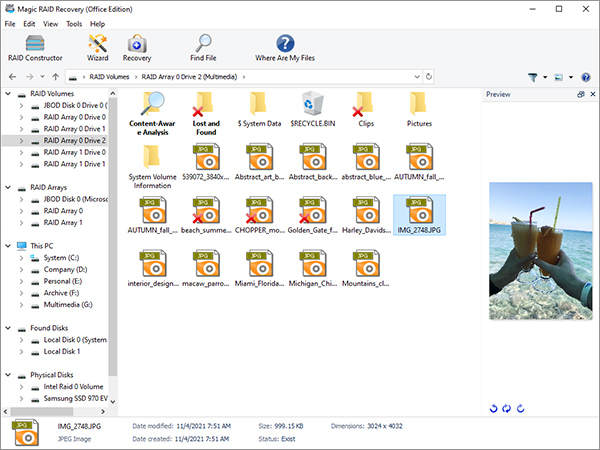
Recover Data from NAS Devices
Synology, QNAP, ASUSTOR, Western Digital, Thecus, TerraMaster, Buffalo, and many other Network Attached Storage (NAS) devices are readily available. However, the limited system resources and restrictive user interfaces of many pre-build NAS solutions may render the data inaccessible should one of the hard drives in multiple-disk volumes fail, even for redundant arrays.
Magic RAID Recovery makes it possible to save your files and folders by connecting the remaining disks directly to your computer and extracting the data without lengthy and unreliable rebuilding/resilvering.
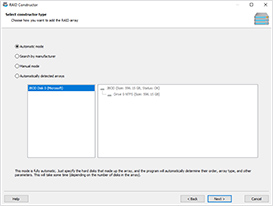
Extract Data from Failing and Corrupted Disks
A NAS device is not always about RAID, or disk volumes spanned across multiple hard drives. Sometimes it’s just a single disk or a JBOD array formatted in a file system not recognized by your computer.
Magic RAID Recovery can help you extract your files and folders by automatically detecting the file system type and making the data accessible on your Windows PC. All major file systems used in Windows (NTFS, ReFS, FAT, FAT32, exFAT), macOS (APFS, HFS+), Linux (Ext2, Ext3, Ext4, XFS, Btrfs, ReiserFS), and Unix (UFS 1, UFS 2) are supported.
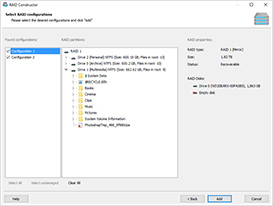
Single-Disk and Multi-Disk Volumes
Magic RAID Recovery was tested on hundreds of single-disk and multiple-disk storage configurations. The RAID system recovery tool supports all types of RAID arrays, including those managed by mdadm (all common NAS units), software and hardware RAID controllers. The RAID server recovery tool recognizes RAID 0, RAID 1, RAID 4, RAID 5, and RAID 6 arrays including exotic configurations (RAID 1E, RAID 5E, RAID 5EE) and composite arrays (RAID 01, RAID 10, RAID 50, RAID 60). Single-disk volumes and JBOD arrays are also supported. RAID partition recovery, mdadm RAID recovery, QNAP RAID recovery, and much more: the tool supports all kinds of files.
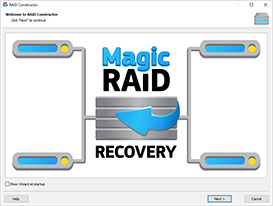
Partial Data Extraction
Depending on the type of the RAID array, it may tolerate one or more faulty hard drives. However, it is common for parity-based arrays to have another disk fail when recovering from a single-disk failure. You can reduce the possibility of the second failure by using the RAID failure recovery feature to quickly recover the data instead of performing the full resilvering. If the second disk had already failed, the RAID recovery utility would apply complex algorithms to attempt recovering the files that are still accessible on the remaining disks. Needless to say that Magic RAID Recovery will recover 100% of the data if the remaining disks are enough for complete recovery.
Wide Range of RAID Controllers
While many controllers advertise support for the various RAID levels, the devil is in the detail. Manufacturers of the different RAID controllers have their own preferences on confining non-essential parameters of the array. As a result, one cannot make assumptions about the stripe size or parity. Magic RAID Recovery supports a wide range of RAID controllers, including those built into Intel-based motherboards and those manufactured by HP, Dell, Adaptec, and many others, including server models.
Extract Data from Degraded Arrays
From time to time, a NAS device or RAID controller may throw the disk out for various reasons, immediately putting the array into a degraded state. In some instances, re-adding the disk only leads to the same problem repeated after many hours of resilvering. The disk may be perfectly readable outside the enclosure with longer than expected timeouts (which is often the case for SMR drives), or there might be just a few bad blocks not affecting the majority of the data. The RAID recovery tool allows remounting such arrays and extracting the data without lengthy synchronization.
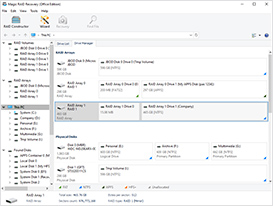
Recover Data from Corrupted Volumes
A perfectly healthy RAID might be unreadable because of corrupted file system structures. Rebuilding or resilvering such arrays would be a waste of time, while inaccessible volumes can be repaired by reconstructing their file system structures. Magic RAID Recovery can check the volume and safely extract the original files and folders.
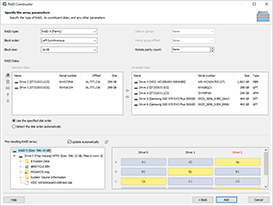
Advanced Manual Mode
Fully automated performance has its benefits as well as drawbacks. If you are an advanced user and know your RAID or work in a data recovery lab, you may achieve a higher recovery rate by manually specifying the correct RAID parameters. Should you know only some characteristics of the RAID array, Magic RAID Recovery will help identify the remaining parameters automatically.
Help
Useful Articles
Tech Specification
Supported RAID Levels
Standard
- RAID-0
- RAID-1
- RAID-4
- RAID-5
- RAID-6
Enhanced
- RAID-1e
- RAID-5e/5ee
Hybrid
- RAID-01
- RAID-10
- RAID-50
- RAID-60
Additional
- JBOD
- X-Raid
- Raidz 1/2/3
NAS/SAN Servers
D-Link, Iomega, Netgear, Seagate, SmartStor, Thecus, QNAP, Zyxel and many-many others
RAID Controllers
Adaptec, Areca, Dell, Fujitsu, HP, IBM, Intel, LSI, MegaRAID, NEC and many-many others
Software RAIDs
Apple, Linux (Btrfs / LVM / Mdadm), Windows RAID Volumes, Windows Storage Spaces
Operating System
- Windows (XP / Vista / 7 / 8 / 10 / 11)
- Windows Server (2008 / 2012 / 2016 / 2019)
- macOS (10.4 Tiger – 15 Sequoia)
- Linux (Ubuntu, Debian, Fedora, Red Hat…)
Hardware Requirements
- CPU: X86 or X64 architecture with minimum main frequency 550MHz
- RAM: 1 GB or more
- The administrative privileges
Features Overview
All types of
RAID arrays
All types of
RAID controllers
Fully automatic
RAID detection
On-the-fly
recovery
All Windows, Linux
and macOS file systems
Supports all types of RAID arrays, including Windows Storage Spaces
Magic RAID Recovery by East Imperial Soft recognizes all types of RAID arrays created with a wide range of controllers. The following basic RAID levels are supported: RAID 0, RAID 1, RAID 4, RAID 5, and RAID 6. In addition, RAID 1E, RAID 5E, RAID 5EE are also supported. The RAID recovery software for Windows supports the most common composite arrays that combine striping, mirroring, and parity in various combinations, including RAID 01, RAID 10, RAID 50, and RAID 60. Single-disk volumes and concatenated JBOD arrays are also supported.
In addition to “classic” arrays, Magic RAID Recovery has been tested on various software arrays, including the popular Windows Storage Spaces, a feature that combines multiple hard drives into a single virtual volume. Storage Spaces work similar to RAID arrays, yet they are implemented entirely on a software level. Storage Spaces can replace a RAID 1 by mirroring data across multiple drives for redundancy, or a RAID 1 by combining several physical drives into a single storage pool. The RAID hard drive recovery software recognizes all types of Windows software arrays.
Recovers information from degraded arrays from all types of RAID controllers
While “R” in “RAID” stands for “Redundant,” redundancy does not mean your storage pool is immune to failures. A failed RAID controller will throw a redundant array out of sync even if the physical hard drives are in perfect order or if the number of failed hard drives allows for the complete RAID controller repair recovery. Rebuilding or resilvering a degraded array in a typical NAS device may take multiple days, all while putting your data at risk by stressing the remaining hard drives and increasing the risk of subsequent failure.
The RAID file recovery software allows recovering information and copying your data off such arrays without waiting for the lengthy synchronization to complete. The data restore tool supports RAID arrays built by all popular RAID controllers, including those built into Intel-based motherboards and those manufactured by HP, Dell, Adaptec, and others, including server models. Software-based arrays created in Windows (Storage Spaces), Linux (mdadm, LVM), and macOS (RAID Assistant) are also supported.
Near-instant and fully automatic
RAID detection
You don’t have to be a seasoned system administrator to use Magic RAID Recovery. The RAID recovery software automatically detects the essential parameters of the RAID array, including the manufacturer and type of the RAID controller, the RAID level, stripe size, and other things required to mount the volume. More often than not, by the time you see the main window, the RAID array you are about to recover will be already mounted and ready for extraction.
If full-auto mode is not your cup of tea, you are welcome to use the advanced manual mode. In manual mode, you can specify all or some parameters of the RAID array. Even then, you won’t have to go deeper in the detail than you want to: should you omit some parts of the configuration data, and the RAID data recovery software will detect them automatically to fill them in.
On-the-fly recovery
with insufficient parity
A RAID 5 array can lose a single disk and still retain 100% of the data, while a RAID 6 can lose any two. A composite array may tolerate the loss of multiple drives depending on the configuration. Resilvering a parity-based array stresses the remaining hard drives, thus dramatically increasing the chance of a subsequent failure. If one more disk fails, you won’t be able to read any data by using the RAID controller or NAS device.
Magic RAID Recovery is designed to squeeze everything down to the last bit out of parity-based arrays. The RAID drive recovery software dynamically calculates parity using your computer’s powerful CPU to restore those files that can still be recovered. Even if more than the supported number of disks are missing from the array, the hardware RAID recovery program may still recover some data by extracting all available parity stripes and using complex algorithms to rebuild the original data.
Supports all Windows, Linux, and macOS file systems, including raw
Even if you can reconstruct a storage pool out of multiple disks, you still have the logical volume(s) to deal with. A Linux file system won’t be recognized in Windows, and vice versa. If you are using a Windows PC, and your NAS system is running Linux, you’ll need special RAID array recovery software to mount the file system and see the files on your computer. Magic RAID Recovery will do that automatically by detecting the file system type and making the files and folders accessible on your Windows PC. The tool recognizes all major file systems used in Windows (NTFS, ReFS, FAT, exFAT), macOS (APFS, HFS+), Linux (Ext2/3/4, XFS, ReiserFS), and Unix (UFS 1/2).
What if there is no recognizable file system on the disk, or if the file system is corrupted beyond repair? If this is the case, Magic RAID Recovery will employ the deep scan technique to recover files in known formats. The RAID array data recovery tool will find images, videos, documents, and archives in multiple formats by matching information from the disks against a built-in database containing characteristic signatures of known file types. If a file of a known type is recognized, the Windows RAID recovery tool will scan its header and calculate its exact size and location on the volume.
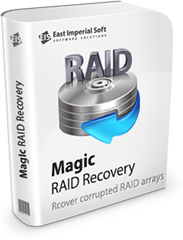
What Others Are Saying
After my old four-bay NAS box had failed, I had the choice of buying a replacement four-bay box or migrating to dual bays with larger disks. Magic RAID Recovery helped me migrate the data without a fuss.
I had four 3TB Seagate drives in a RAID 5. One of the drives died. I didn’t want to risk my data by letting the RAID rebuild, and used Magic RAID Recovery to copy the files over to a single 10TB external.
A failed firmware update bricked my Qnap NAS. Support didn’t help reviving the unit, so I used Magic RAID Recovery that helped me save my data to the newer and bigger replacement disk.
Thank you!
Recommended Products


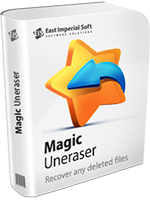
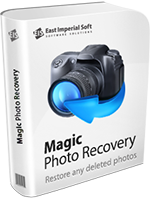
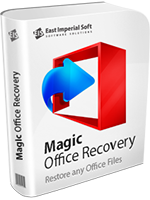
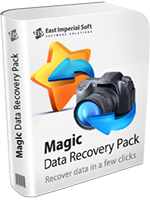

Magic Partition Recovery
Accidentally formatted your hard drive? Deleted or modified its file system? Your system says that partition is corrupted and needs formatting?
Recover lost information, repair broken partitions and rebuild damaged file systems in fully automated mode. No matter how badly damaged your disk is and whether you have a file system on it or it’s completely gone, Magic Partition Recovery can carefully recover your files and reconstruct the partition system structures.
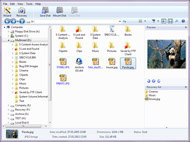

Magic Browser Recovery
Recover information from a wide range of Web browsers. Access stored passwords, bookmarks, browsing history, and social activities.
Magic Browser Recovery will automatically identify Web browsers ever used on the computer and perform a comprehensive scan of your computer’s file system and disk surface to recover passwords, bookmarks, browsing history and activities in social networks.
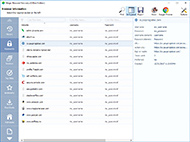

Magic Uneraser
Have you deleted important document MS Office, DVD video, mp3 file or photo? Restore any deleted file using Magic Uneraser!
Magic Uneraser offers fully guided, step-by-step approach to recovering deleted files. Supporting all versions of Windows, macOS and Linux, Magic Uneraser allows you to unerase deleted files and recover information from all types of storage media.
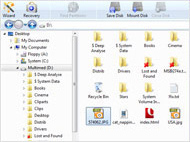

Magic Photo Recovery
Recover all types of images quickly and reliably! Magic Photo Recovery recovers deleted photos from hard drives, memory cards or digital cameras.
Magic Photo Recovery makes digital photo recovery easy. The fully guided, step-by-step file recovery wizard allows unerasing deleted photos completely automatically. You can recover files from healthy and damaged hard disks and digital cameras, corrupted and formatted memory cards, etc.


Magic Office Recovery
Deleted an important document? Formatted a disk containing your working files? The operating system won’t let you open a disk?
Magic Office Recovery can undelete documents and spreadsheets, recovering files from damaged, corrupted, formatted and inaccessible devices. Built-in document integrity checks ensure 100% recoverability, while step-by-step wizards and thumbnail view make the recovery process easy and convenient.
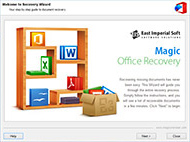

Magic Data Recovery Pack
Recover deleted files, undelete music, unerase movies, documents and pictures with the most advanced file recovery software!
Magic Data Recovery Pack offers the most advanced file recovery capabilities in a single package. Recovering files from all types of storage media, Magic Data Recovery Pack can recover deleted information from all versions and revisions of NTFS, ReFS, FAT, exFAT, APFS, HFS+, Ext2/3/4, XFS, ReiserFS and UFS file systems.
